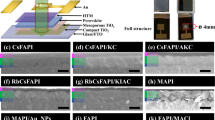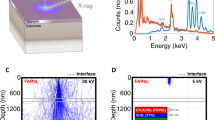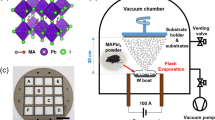Abstract
Optimizing the morphology of metal halide perovskite films is an important way to improve the performance of solar cells1 when these materials are used as light harvesters2, because film homogeneity is correlated with photovoltaic performance3. Many device architectures and processing techniques have been explored with the aim of achieving high-performance devices4, including single-step deposition5, sequential deposition6,7 and anti-solvent methods1,8. Earlier studies have looked at the influence of reaction conditions on film quality3, such as the concentration of the reactants9,10 and the reaction temperature11. However, the precise mechanism of the reaction and the main factors that govern it are poorly understood. The consequent lack of control is the main reason for the large variability observed in perovskite morphology and the related solar-cell performance2,3. Here we show that light has a strong influence on the rate of perovskite formation and on film morphology in both of the main deposition methods currently used: sequential deposition and the anti-solvent method. We study the reaction of a metal halide (lead iodide) with an organic compound (methylammonium iodide) using confocal laser scanning fluorescence microscopy and scanning electron microscopy. The lead iodide crystallizes before the intercalation of methylammonium iodide commences, producing the methylammonium lead iodide perovskite. We find that the formation of perovskite via such a sequential deposition is much accelerated by light. The influence of light on morphology is reflected in a doubling of solar-cell efficiency. Conversely, using the anti-solvent method to form methyl ammonium lead iodide perovskite in a single step from the same starting materials, we find that the best photovoltaic performance is obtained when films are produced in the dark. The discovery of light-activated crystallization not only identifies a previously unknown source of variability in opto-electronic properties, but also opens up new ways of tuning morphology and structuring perovskites for various applications.
This is a preview of subscription content, access via your institution
Access options
Access Nature and 54 other Nature Portfolio journals
Get Nature+, our best-value online-access subscription
$29.99 / 30 days
cancel any time
Subscribe to this journal
Receive 51 print issues and online access
$199.00 per year
only $3.90 per issue
Buy this article
- Purchase on Springer Link
- Instant access to full article PDF
Prices may be subject to local taxes which are calculated during checkout




Similar content being viewed by others
References
Bi, D. et al. Efficient luminescent solar cells based on tailored mixed-cation perovskites. Sci. Adv. 2, e1501170 (2016)
Salim, T. et al. Perovskite-based solar cells: impact of morphology and device architecture on device performance. J. Mater. Chem. A 3, 8943–8969 (2015)
Sharenko, A. & Toney, M. F. Relationships between lead halide perovskite thin-film fabrication, morphology, and performance in solar cells. J. Am. Chem. Soc. 138, 463–470 (2016)
Grätzel, M. The light and shade of perovskite solar cells. Nat. Mater. 13, 838–842 (2014)
Im, J. H., Lee, C. R., Lee, J. W., Park, S. W. & Park, N. G. 6.5% efficient perovskite quantum-dot-sensitized solar cell. Nanoscale 3, 4088–4093 (2011)
Burschka, J. et al. Sequential deposition as a route to high-performance perovskite-sensitized solar cells. Nature 499, 316–319 (2013)
Liang, K., Mitzi, D. B. & Prikas, M. T. Synthesis and characterization of organic−inorganic perovskite thin films prepared using a versatile two-step dipping technique. Chem. Mater. 10, 403–411 (1998)
Jeon, N. J. et al. Solvent engineering for high-performance inorganic-organic hybrid perovskite solar cells. Nat. Mater. 13, 897–903 (2014)
Im, J. H., Jang, I. H., Pellet, N., Grätzel, M. & Park, N. G. Growth of CH3NH3PbI3 cuboids with controlled size for high-efficiency perovskite solar cells. Nat. Nanotechnol. 9, 927–932 (2014)
Bi, D., El-Zohry, A. M., Hagfeldt, A. & Boschloo, G. Unraveling the effect of PbI2 concentration on charge recombination kinetics in perovskite solar cells. ACS Photon. 2, 589–594 (2015)
Ahn, N., Kang, S. M., Lee, J.-W., Choi, M. & Park, N.-G. Thermodynamic regulation of CH3NH3PbI3 crystal growth and its effect on photovoltaic performance of perovskite solar cells. J. Mater. Chem. A 3, 19901–19906 (2015)
Kondo, S., Ohsawa, H., Asada, H. & Saito, T. Inherent excitonic luminescence in metal halide promising for potential applications in light-emitting devices. J. Appl. Phys. 107, 103526 (2010)
Harms, H. A., Tetreault, N., Pellet, N., Bensimon, M. & Grätzel, M. Mesoscopic photosystems for solar light harvesting and conversion: facile and reversible transformation of metal-halide perovskites. Faraday Discuss. 176, 251–269 (2014)
Sandroff, C. J. Clusters in solution: growth and optical properties of layered semiconductors with hexagonal and honeycombed structures. J. Chem. Phys. 85, 5337–5340 (1986)
Zheng, Z. et al. In situ growth of epitaxial lead iodide films composed of hexagonal single crystals. J. Mater. Chem. 15, 4555–4559 (2005)
Ahmad, S., Kanaujia, P. K., Niu, W., Baumberg, J. J. & Vijaya Prakash, G. In situ intercalation dynamics in inorganic-organic layered perovskite thin films. ACS Appl. Mater. Interfaces 6, 10238–10247 (2014)
Liu, F., Sommer, F., Bos, C. & Mittemeijer, E. J. Analysis of solid state phase transformation kinetics: models and recipes. Int. Mater. Rev. 52, 193–212 (2007)
Mullin, J. W. Industrial Crystallization 3–22 (Plenum, 1975)
Balluffi, R. W ., Allen, S. M . & Carter, W. C. Kinetics of Materials 459–463 (Wiley & Sons, 2005)
Kramer, D. Dependence of surface stress, surface energy and surface tension on potential and charge. Phys. Chem. Chem. Phys. 10, 168–177 (2008)
Bard, A. J. Electrochemical Methods: Fundamentals and Applications 2nd edn, 53–54, 540–544 (Wiley, 2001)
Wu, Y. et al. Retarding the crystallization of PbI2 for highly reproducible planar-structured perovskite solar cells via sequential deposition. Energy Environ. Sci. 7, 2934–2938 (2014)
Ratke, L . & Voorhees, P. W. Growth and Coarsening: Ostwald Ripening in Material Processing 1–2 (Springer, 2002)
Tress, W., Corvers, S., Leo, K. & Riede, M. Investigation of driving forces for charge extraction in organic solar cells: transient photocurrent measurements on solar cells showing s-shaped current–voltage characteristics. Adv. Energy Mater. 3, 873–880 (2013)
Khanna, P. K., Singh, N., Charan, S. & Viswanath, A. K. Synthesis of Ag/polyaniline nanocomposite via an in situ photo-redox mechanism. Mater. Chem. Phys. 92, 214–219 (2005)
Saliba, M. et al. Incorporation of rubidium cations into perovskite solar cells improves photovoltaic performance. Science 354, 206–209 (2016)
Correa-Baena, J.-P. et al. Unbroken perovskite: interplay of morphology, electro-optical properties, and ionic movement. Adv. Mater. 28, 5031–5037 (2016)
Moore, D. T. et al. Crystallization kinetics of organic-inorganic trihalide perovskites and the role of the lead anion in crystal growth. J. Am. Chem. Soc. 137, 2350–2358 (2015)
Saliba, M. et al. Cesium-containing triple cation perovskite solar cells: improved stability, reproducibility and high efficiency. Energy Environ. Sci. 9, 1989–1997 (2016)
Klintenberg, M. K., Weber, M. J. & Derenzo, D. E. Luminescence and scintillation of PbI2 and HgI2 . J. Lumin. 102–103, 287–290 (2003)
Calloni, A. et al. Stability of organic cations in solution-processed CH3NH3PbI3 perovskites: formation of modified surface layers. J. Phys. Chem. C 119, 21329–21335 (2015)
Acknowledgements
Financial support was provided by the Swiss National Science Foundation through grant no. 200021-157135/1. We thank S. M. Zakeeruddin for help with the administration of this grant. T.M. was on leave of absence from the Panasonic Corporation and his stay at EPFL was supported by the Panasonic Corporation. We acknowledge J.-P. Correa-Baena and N. Pellet for assistance with SEM. We thank C. Yi for experimental help, and M. Mayer and R. Humphry-Baker for discussions. We acknowledge K. Schenk, L. Bozzo (BIOP, EPFL) and R. Guiet (BIOP, EPFL) for help with XRD analysis, CLSM and image processing, respectively.
Author information
Authors and Affiliations
Contributions
A.U. conceptualized and designed the study, analysed the data and prepared the manuscript. A.U. prepared the samples and devices using sequential deposition and conducted the experiments. A.U. captured and processed the CLSM images. A.U. and L.S. conducted the electrochemical experiments. L.S. carried out the impedance measurements. L.S. and J.-Y.S. collected the SEM images. T.M., A.A. and A.U. prepared the CH3NH3PbI3 devices using the anti-solvent method. J.-Y.S. prepared the high-efficiency devices using the quadruple-cation composition. W.T. was involved in the design of the electrochemical experiments, data analysis and editing of the manuscript. M.G. directed the study. All authors discussed the results and commented on the manuscript.
Corresponding author
Ethics declarations
Competing interests
The authors declare no competing financial interests.
Additional information
Reviewer Information Nature thanks X. Duan and the other anonymous reviewer(s) for their contribution to the peer review of this work.
Publisher's note: Springer Nature remains neutral with regard to jurisdictional claims in published maps and institutional affiliations.
Extended data figures and tables
Extended Data Figure 1 Growth of PbI2 nuclei under different conditions in sequential deposition.
a, SEM image showing a standard unreacted PbI2 film (as-deposited). b, c, SEM images of standard PbI2 films dipped in MAI solution for 4 s: in the dark showing low crystal density (b) and under 1 Sun light intensity showing high crystal density (c). d, e, SEM images of PbI2 films annealed at 100 °C for 1 h, dipped in MAI solution for 4 s: in the dark (d) and under 1 Sun light intensity (e). Scale bars (a–e), 1 μm. It is interesting to compare samples made under 1 Sun light intensity, as the light-activated nucleation is expected to take place and the affinity for nucleation can be assessed. Image e shows a sample of initially high crystallinity with substantially fewer crystals growing on the surface after dipping, compared to the analogous standard sample in c, indicating that amorphous PbI2 is required for the growth of nuclei. f, XRD analysis showing the full-width at half-maximum (FWHM) of the Voigt function fits of the (001) reflection of the 2H polytype of PbI2 and the corresponding height of the platelet obtained using the Scherrer equation. We observe an increase in platelet height from 17 nm to 36 nm on annealing the standard PbI2 sample at 100 °C for 1 h. The platelet height increases from 17 nm in the standard unreacted PbI2 film, to 20 nm and 29 nm, on dipping in 0.038 M MAI in 2-propanol in the dark and under 1 Sun illumination, respectively. On dipping standard PbI2 films in 0.038 M EMIm TFSI in 2-propanol (for equivalence with 0.038 M MAI in 2-propanol), an increase in the platelet height from 17 nm to 19 nm and 24 nm was observed, for dipping in the dark and under 1 Sun, respectively. This is similar to the trend seen for dipping in MAI. See Methods for details.
Extended Data Figure 2 SEM images of CH3NH3PbI3 films prepared using sequential deposition under various temperature and light conditions.
PbI2 films were dipped isothermally in MAI solution for 25 s at the following conditions: a, 35 °C under 0.01 Sun illumination; b, 50 °C under 0.01 Sun; c, 35 °C under 1 Sun; and d, 50 °C under 1 Sun. Dipping at a higher temperature and the same light intensity gives larger perovskite crystals; dipping at a higher light intensity and the same temperature gives a higher nucleation density with small crystals. Scale bars (a–d), 2 μm.
Extended Data Figure 3 Electrochemical experiments.
a, b, Photograph (a) and cross-sectional diagram (b) of a PbI2 electrode. c, d, Photograph (c) and diagram (d) of set-up with a PbI2 electrode in contact with 0.38 M EMIm TFSI in 2-propanol, used for chopped light chronopotentiometry and EIS measurement. WE, working electrode; Ref, reference electrode; CE, counter electrode. e, Diagram of set-up used to determine the chemical potential of 0.038 M MAI in 2-propanol (IPA) solution, and f, the corresponding chronopotentiometry experiment data. The chemical potential of the MAI solution was determined to be +0.056 V versus Ag/AgCl, KCl (saturated). g, Variable light chronopotentiometric photo-voltage measurement at zero applied current (dark, 0.01 Sun, 0.1 Sun, 1 Sun and dark). The potential under the initial dark condition is set to zero. h, Mott–Schottky analysis of PbI2 film in the dark, where C is the space-charge layer capacitance normalized by the area considering a geometrically flat surface (equation (4)). A flat band potential (Efb) of −0.46 V versus Ag/AgCl, KCl (saturated) was determined from the x-intercept of a fit of the linear region. The upper limit of the charge carrier concentration (ND), considering a geometrically flat surface, was obtained as 8 × 1019 cm−3. i, Energy levels versus Ag/AgCl, KCl (saturated) and the equivalent value versus the vacuum level shown. The Ag/AgCl, KCl (saturated) reference electrode was calibrated by dissolving ferrocene (Fc) in the ionic liquid solution and verifying that the position of the Fc/Fc+ couple was +0.4 V versus Ag/AgCl, KCl (saturated), consistent with the literature21. The energy levels determined from f, g and h are shown. Electron-quasi-Fermi level under illumination is denoted by  . Reported values31 for the conduction band (CB) and valence band (VB) edges of PbI2 are also shown.
. Reported values31 for the conduction band (CB) and valence band (VB) edges of PbI2 are also shown.
Extended Data Figure 4 Energy band diagrams of PbI2 film and 0.038 M MAI in 2-propanol solution in the dark and under 1 Sun illumination.
Diagrams constructed using data from Extended Data Fig. 3i and band bending assumed in both cases. EF, Fermi level; μMAI, chemical potential of the electrolyte (MAI solution). a, In the dark, after contact and electrostatic equilibration, and b, under 1 Sun illumination, with the limits of surface traps obtained from the Mott–Schottky analysis shown in blue. Quasi Fermi level for holes not shown.
Extended Data Figure 5 Effect of populating surface traps.
Shown are SEM images of PbI2 films that have been dipped for 6 s in 0.038 M MAI in 2-propanol solution; a, in the dark, no voltage bias; b, under 0.02 Sun illumination, no voltage bias; and c, under 0.02 Sun illumination, bias of +0.8 V versus the Nernst potential of MAI. Panels b and c show comparable nucleation density, while that in a is low. Scale bars (a–c), 2 μm.
Extended Data Figure 6 Statistical analysis of photovoltaic data (backward scans) recorded under simulated AM1.5G illumination.
Left-hand panels (a–d) represent 5 CH3NH3PbI3 devices of each condition (dipped into MAI solution in the dark, and under 0.1 Sun and 1 Sun illumination) fabricated using sequential deposition. Centre panels (e–h) represent 6 CH3NH3PbI3 devices of each condition (made in the dark and under 1 Sun illumination) prepared using the anti-solvent method. Right-hand panels (i–l) represent 10 quadruple-cation perovskite devices of each condition (made in the dark and under 1 Sun illumination) prepared using the anti-solvent method. a, e, i, Short-circuit current density (Jsc). b, f, j, Open-circuit voltage (Voc). c, g, k, Fill factor (FF). d, h, l, Power conversion efficiency (PCE). The upper and lower error bars represent the maximum and minimum values respectively, and the mid-line in each box represents the median value. The top and the bottom of the box represent the upper quartile (75th percentile, Q3) and lower quartile (25th percentile, Q1) respectively, and box height represents the interquartile range (Q3–Q1). Filled squares indicate the mean values shown in Extended Data Table 1. See Methods for details of illumination.
Extended Data Figure 7 Photovoltaic device characterization and analysis of CH3NH3PbI3 samples made using sequential deposition.
a–c, SEM images of the perovskite films corresponding to devices dipped into MAI solution in the dark, and under 0.1 Sun and 1 Sun respectively. Scale bars (a–c), 1 μm. d, Absolute IPCE spectra (solid lines) and the integrated current densities (dashed lines) of representative devices dipped into MAI solution in the dark and under 1 Sun. e, XRD spectra of perovskite films dipped into MAI solution in the dark, and under 0.1 Sun and 1 Sun. The main reflections corresponding to the tetragonal perovskite have been indicated. *Reflections of the PbI2 in the 2H polytype; §reflections from the FTO. Similar amounts of PbI2 remain in all the films.
Extended Data Figure 8 Absolute IPCE spectra (solid lines) and the integrated current densities (dashed lines) of representative devices prepared using the anti-solvent method in the dark and under 1 Sun illumination.
a, CH3NH3PbI3; b, quadruple-cation composition26.
Supplementary information
Supplementary Information
This file contains a Supplementary discussion on CLSM images of CH3NH3PbI3 formation in sequential deposition shown in Figure 1. It also contains discussion on photo-electrochemical experiments characterizing the PbI2-electrolyte interface and identifying the carrier trapped in PbI2 surface traps and a discussion on the crystallization of PbI2 in an ionic liquid and alternative photo-redox mechanism. (PDF 188 kb)
Rights and permissions
About this article
Cite this article
Ummadisingu, A., Steier, L., Seo, JY. et al. The effect of illumination on the formation of metal halide perovskite films. Nature 545, 208–212 (2017). https://doi.org/10.1038/nature22072
Received:
Accepted:
Published:
Issue Date:
DOI: https://doi.org/10.1038/nature22072
This article is cited by
-
In-situ growth of low-dimensional perovskite-based insular nanocrystals for highly efficient light emitting diodes
Light: Science & Applications (2023)
-
Tuning photocatalytic performance of Cs3Bi2Br9 perovskite by g-C3N4 for C(sp3)—H bond activation
Nano Research (2023)
-
Kinetics and energetics of metal halide perovskite conversion reactions at the nanoscale
Communications Materials (2022)
-
Infrared photon-assisted annealing for crystal engineering in perovskite solar cells
Bulletin of Materials Science (2022)
-
Effect of Adding Cobalt Acetate on Performance of Fully Screen-Printable Perovskite Solar Cells
Journal of Electronic Materials (2022)
Comments
By submitting a comment you agree to abide by our Terms and Community Guidelines. If you find something abusive or that does not comply with our terms or guidelines please flag it as inappropriate.



